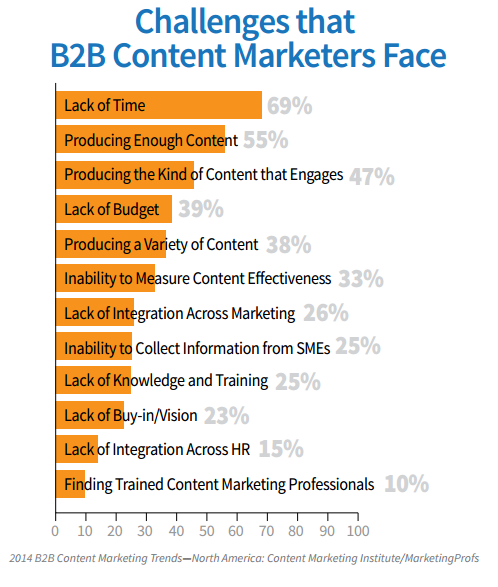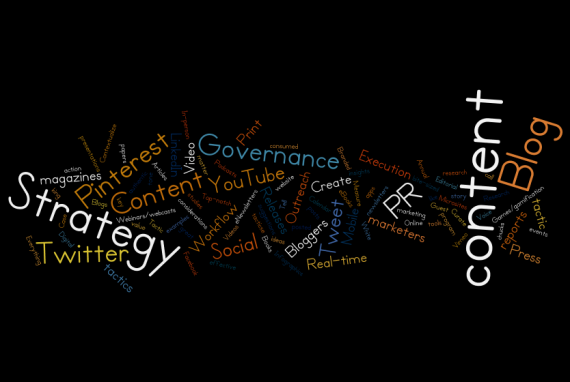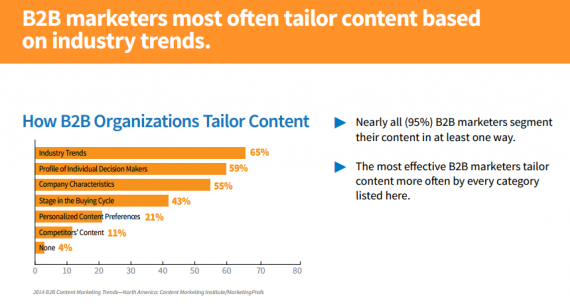
Why?
Last week at South By Southwest, Kristina Halvorson was talking about the challenges that B2B marketers claim to face when it comes to content marketing. Halvorson was mid-way through her presentation titled, Go home marketing, you are drunk, and she was specifically referencing data similar to the second and third data points presented below, when she popped the "Why?" question.

Halvorson confirmed that these are the problems that are constantly thrown at her when she is discussing content strategy with organizations and c-level executives:
- Producing Enough Content: 55%
- Producing the Kind of Content that Engages: 47%
*Note: Halverson's data was from 2010
Yet Halvorson said that whenever she hears comments like:
"How quickly can you help us with these problems? We've gotta hurry, we've gotta hurry! Our website is lacking with content!"
She is consistently forced to ask:
"Why? Why do you need this content?"
A simple question coming from the woman who literally wrote the book on content strategy (Content Strategy For The Web by Kristina Halvorson & Melissa Rach - still the best book I've found when it comes to understanding and defining the discipline of web-focused content strategy.)
Sometimes the "Why?" question is avoided because there is fear that it can lead to too many complicated answers. But in most cases the answers matter less than the chain reaction that comes from asking the question. Why do you believe you need MORE content? Why do you believe your content is the wrong kind?
Often asking "Why?" leads to simple realizations like, "We do already have a ton of content. Let's fix what we already have, before we start cranking out more." Because too often, the act of creating more only makes things worse, and continues to clutter up the real answers to the "Why?" question.
Yet for many reasons, the "Why?" question still goes unasked far too often.

Let's take a moment to recognize that content marketing advice is not hard to come by these days:
- Content is king.
- Quality content matters more than ever.
- Fresh content is imperative.
- Your content must be engaging.
- Your content must be relevant.
- Your content must be consistent.
- Your content must be clear.
- Etc.
And luckily these commonplace expressions and ideas have started to give way to discussions around more actionable processes and ideas for developing a content strategy, such as:
- qualitative content audits,
- content governance plans,
- editorial calendars,
- style-guides,
- workflows that work.
But the content strategy conversation is still very cluttered, and unfortunately misunderstood pain points can often exacerbate the issues around providing your audience with content they need and value.
What follows are three considerations that can not afford to be left out of the content strategy conversation and process.
Listen First
You've probably heard this one before: your website is a phone, not a file cabinet. Ginny Redish established this principle in her book Letting Go of the Words, and even though the virtual file cabinet approach to building a web site has luckily faded, the core point of needing to understand the conversations your visitors want to have with your web site or app, is still often overlooked. Once you understand the conversations your visitors want to have with your web site, and with each other, you can move closer to creating web content to satisfy those conversations.
So, how do you understand those conversations?
The first point to remember is that every visit to your web site is a conversation started by that user/visitor. So you can use the analytic tools at your disposable to understand the visits, and move closer to understanding that visitors' conversations (i.e.: compared prices, skimmed a blog post, viewed the About Us page, visited the Job Opportunities page, shared a video, etc.)
But, if you want to truly listen and understand your customers conversations, don't get hung up on the tools. Tools can help us ask questions, but they also can prevent us from truly listening. Instead focus on the most concrete forms of customer research you can get your hands on. Demographics can help, but you need to try and learn more about your customers than just demographics, you want to try and learn their behavior. Use A/B testing when possible. Don't be afraid to ask your current and potential customers questions. (One simple way to flesh this out is by tapping into the knowledge your sales team may have, if applicable.)
Take the graph below as an example. Even though the this graph is B2B specific, doesn't there seem to be something missing when it comes to tailoring content to the needs of the target audience? Content around industry trends may scratch the surface on this, but does it go far enough to meet the needs of the target audience?

It's NOT About Engagement, It's About Experience
Engagement is not how often people read or view, nor is it about "liking" or "recommending." Instead, engagement is about a collective set of experiences that audiences have with the brand. As defined in the Northwestern University Medill School of Journalism text on Media Engagement: experiences are how people feel, think and act when they consume your content or use your product. It is the collective set of experiences that a person has with the content that creates an overall engagement with the brand or product.
I'm reminded by the sentence highlighted in the video below: "the first thing we ask is what do we want people to feel?"
It's worth remembering that all content will create user experiences in some way; experience free content does not exist. Therefore, understanding that experience drives usage means that if people have positive experiences with your content, they are more apt to use it and/or visit it more. (To understand experiences more in depth, visit the following: Content Strategy MOOC from Northwestern University).
Experiences are applied at the following three levels when developing content: message, distribution, and strategic levels. Once you have listened to your audience and understand their conversations, you will be able to move closer to understanding what experiences matters to them, and in the end this will lead to you deciding what stories you are going to tell, and what stories you are NOT going to tell.
Which brings us to the fact that:
It's All About Story
Stories can be the most complex and yet the most simple aspect of defining your content strategy. Why? Because in its simplest form: human beings order the word dialectically. We can't process randomness, therefore we impose an order on what we observe. John Yorke, the creator of the BBC Writer's Academy, explains it as follows:
"We exist; we observe new stimuli; and both are altered in the process. It's thesis, antithesis, synthesis. Students encounter something of which they're unaware, explore and assimilate it, and by merging it with their pre-existing knowledge, grow. Every act of perception is an attempt to impose order, to make sense of a chaotic universe. Storytelling, at one level, is a manifestation of this process...It is an organic codification of the human mechanism for ordering information."
The key to understanding which stories to tell via your content strategy is understanding your audience's definition of story. Above is an example of one man's eloquent attempt to define storytelling and it's biological significance, however the way we tell stories is changing, and stories mean different things to many different people.
The difference between bits of information and stories are blurring, and as the medium with which we tell stories evolves, people's personal definitions of what a story is and isn't evolves as well. For example, one person may prefer long-form articles, while another may prefer interactive video, and another may insist that Instagram is the only way they can tell and share their story.
Yes, we need to use storytelling to capture our audience's imaginations in a meaningful way, but don't lose sight of how your audience tells and processes stories.
Next time you feel compelled to push for the creation of new content, consider taking the small, simple step of asking, "Why?" The answers will help you cut through the clutter and remind you of the core concepts to consider when developing strategy.


